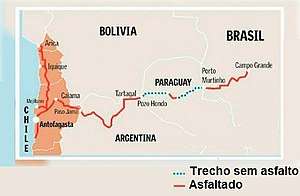Central Bi-Oceanic railway
The Bioceanic Corridor (Portuguese: Corredor Bioceánico) is a road project between Brazil, Paraguay, Argentina and Chile.[1][2] The project would join the port of Santos, Brazil on the coast of the Atlantic Ocean with the port of Iquique and Antofagasta, Chile, on the coast of the Pacific Ocean.[3]

Project
In his trip to China in 2013, Bolivian president Evo Morales discussed with Xi Jinping, General Secretary of the Communist Party of China, the possibility of building a railway to link the Atlantic with the Pacific through Brazil and Peru. The Chinese president requested a study of feasibility by 2014.[4]
The Spanish narrow gauge rail company, FEVE, was awarded a contract by the Bolivian government to prepare a technical feasibility study.[5] The first studies were prepared by Spanish, French and Bolivian consultants and were to be delivered by June 2014.[6]
In August 2014, a mission from Bolivia sought financing from the Chinese government.[7][8]
The summit of the Union of South American Nations (Unasur) in December 2014, prioritised the project along with seven other regional integration projects.[9]
The project contemplates four baseline studies: the basic engineering design, the market study, the strategic study and the environmental study.[10] The four studies would be complete by 31 December 2014.[11]
The Bolivian minister of Public Works, Services and House, Vladimir Sánchez, stated the first phase is to build the railroad; the second phase is to electrify the railroad, and a third phase is to have a double-track railroad.
The project looks for 95% of the trade of the south and North of the Peru, as well as the integration to Brazil.[12]
Changes at the project
In August 2017, the 2nd Expedition of the Latin American Integration Route took place, departing from Campo Grande and covering its entire length to the Chilean ports of Iquique and Antofagasta, the final stop. The route passed through 4 countries: Brazil, Paraguay, Argentina and Chile. The 1st Expedition traveled through Bolivia, to Chilean ports. Due to the recent history with the Bolivian government, it was decided that the route should follow via Paraguay and Argentina. The idea is that the corridor will be completed in 2022. Most of the work will be carried out by Paraguay, which will need to pave more than 600 km of its highways, which were still unpaved. The route will cover 2400 km between Campo Grande and Antofagasta. [13][14]
The route should reduce the travel time of exports from the Midwest of Brazil to Asia and Oceania (China, Japan, India, Australia) by up to 2 weeks. With the route, part of the Brazilian production, which currently leaves the country through the ports of Santos and Paranaguá, will be exported by Chilean ports at lower prices.[15]
See also
References
- "Evo ve 'jugada sucia' de Perú en el proyecto del tren bioceánico". La Razón. 20 October 2012. Archived from the original on 23 October 2014. Retrieved 27 October 2014.
- "Evo choca con Perú por ruta de Corredor Bioceánico". La Tercera. 21 October 2014. Retrieved 27 October 2014.
- "El ferrocarril que unirá a Perú y Bolivia". La República. 10 December 2013. Archived from the original on 5 November 2014. Retrieved 27 October 2014.
- "China pide estudio de construcción de tren interoceánico". La Paz: La Razón. 29 December 2013. Archived from the original on 1 January 2014. Retrieved 3 August 2015.
- "Se iniciaron estudios para un corredor ferroviario bioceánico". El Día. 2 June 2014. Retrieved 27 October 2014.
- "Corredor ferroviario que uniría a Brasil, Perú y Bolivia tendría un costo de US$10.000M". americaeconomia.com. 26 May 2012. Retrieved 27 October 2014.
- "Gobierno boliviano gestiona corredor bioceánico que conectará Perú y Brasil". americaeconomia.com. 27 July 2012. Retrieved 27 October 2014.
- "Bolivia pedirá ayuda a China para sacar adelante ruta ferroviaria bioceánica". lostiempos.com. 6 August 2014. Archived from the original on 2014-10-27. Retrieved 27 October 2014.
- "Unasur priorizará el corredor bioceánico que incluye a Bolivia". La Razón. 8 December 2014. Archived from the original on 19 December 2014. Retrieved 14 December 2014.
- "Megaproyecto ferroviario apunta a exportar 95% de carga por Perú". La Razón. 25 May 2012. Retrieved 27 October 2014.
- "Bolivia concluirá hasta fin de año estudios para construir tren bioceánico Atlántico-Pacífico". La Razón. 25 November 2014. Archived from the original on 17 December 2014. Retrieved 25 November 2014.
- "Bolivia se entromete y busca gestionarse en China para que tenga una participación en el proyecto de tren interoceánico Brasil-Perú". La Razón. 22 October 2012. Archived from the original on 8 November 2014. Retrieved 27 October 2014.
- Expedição percorre rota que encurta distâncias para exportações de MS
- Cronograma da Rota Bioceânica segue com obras em ritmo acelerado no Paraguai
- Encontro do Corredor Bioceânico avança em projetos turísticos, culturais e comerciais